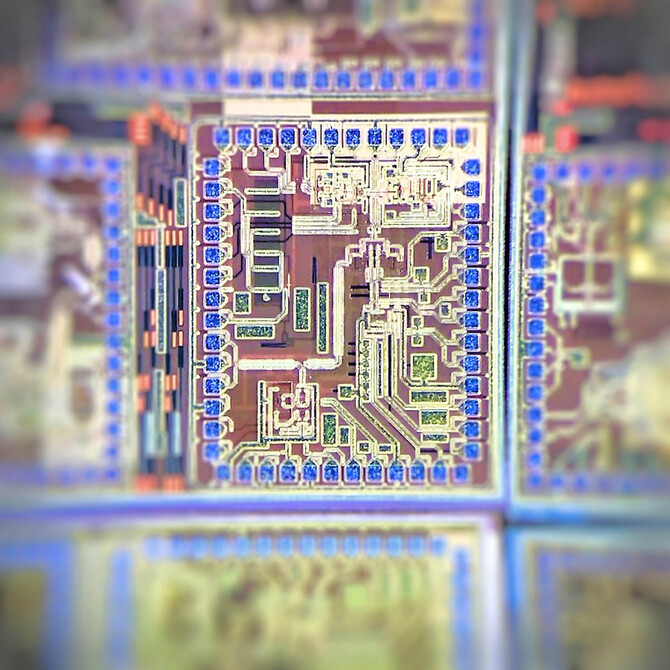Original Post, Penn Today.
With streaming movies and UltraHD television taking more and more bandwidth, there is a race to deliver data into people’s homes as quickly as possible. Light-based fiber optic connections promise far faster data rates than standard electricity-based coaxial cables, so making laser sources smaller, cheaper and more stable is a high priority for engineers.
Engineers at the University of Pennsylvania have now developed a silicon microchip that can significantly reduce the noise of low-cost lasers, enabling them to use the laser’s phase to transmit data. This microchip measures the noise in the laser’s phase in the form of an electrical current, then suppresses the noise by injecting that current back to the laser in a feedback loop. This method, known as the Pound-Drever-Hall (PDH) technique, is a mainstay of laser stabilization, but has thus far only been implemented as benchtop-sized systems. A microchip-sized PDH stabilizer could be inexpensively mass-produced and integrated into existing laser systems, allowing them to perform as well as much larger and more expensive lasers.
“This chip enables information to be encoded in both intensity and phase of a low-cost laser, multiplying the data rate for the same available bandwidth. For example, compared to two-level intensity encoding, you can get four times the data rate if you encode information in eight phase points on top of two intensity levels,” said Firooz Aflatouni, Skirkanich Assistant Professor in Penn Engineering’s Department of Electrical and Systems Engineering in the School of Engineering and Applied Science.
“The beauty of it is that 100 Mb/s becomes 400 Mb/s, using the same cheap, noisy laser,” he said.
Aflatouni, along with Mohamad Hossein Idjadi, a graduate student in his lab, published a study demonstrating the device in Nature Communications.
Most laser based communication systems use intensity modulation, which means encoding the information solely in the light wave’s intensity. For simplicity’s sake, a “1” is when the laser light is on and a “0” is when it is off. But lasers also have other properties: frequency, which is how fast the wave’s up-and-down cycle is repeated, and phase, which is how far the start of each cycle is from a fixed reference point.
To transmit a single bit using only intensity modulation, the laser light just needs to be either on or off at preset intervals, each representing either 0 or 1. A laser capable of emitting four discrete phases, however, could transmit data twice as fast. Each of the phases would represent one of the four two-bit permutations at each interval, 00, 01, 10, or 11.
Combining more phase and intensity levels other than simply “on” and “off” could further multiply the data rate. Encoding information in four phase points and two intensity levels would allow for the eight three-bit permutations, tripling the data rate. Eight phases and two intensities would allow for the sixteen four-bit permutations, quadrupling it. Critically, this system only works if the laser can reliably emit with the correct phase in each interval. Lasers that are low-noise enough to do so are prohibitively expensive for consumer products, and mass-market lasers are typically too noisy to carry information using properties beyond simple on-or-off intensity.
This noise arises from the quality of a laser’s cavity and the “gain medium” within it. Generally, lasers are produced by bouncing light back and forth in a cavity between two mirrors. Because light loses energy as it travels inside the cavity, a gain medium is placed in the light’s path. In a process known as stimulated emission, after applying electric current to the laser’s gain medium, photons are released that are lined up with the light passing through it, amplifying it into a laser beam.
“During this amplification process, some photons are also generated at random, which in turn generate noise in the laser. High quality cavities can significantly reduce this so-called ‘spontaneous emission’ noise resulting in a lower noise laser,” said Aflatouni.
“However, cavities with a high quality factor are expensive and often bulky or complex to design,” he said. “Putting them together is costly and time consuming, since the process must be extremely precise. The technology is there, but manufacturers only make a few hundred of them a year. They’re just too complex and expensive to mass-produce.”
Instead of using expensive lasers with a complex or bulky cavity, the researchers’ PDH chip could be used in conjunction with lasers that have simpler, lower quality cavities.
“We measure the noise in the phase of the laser coming mainly from randomly generated photons in the laser cavity and feed it back as a current to the laser gain medium,” said Idjadi, “This suppresses the noise in the phase of the laser.”
The researchers are then able to tap off a “clean” laser after this feedback loop, replicating the performance of a much more expensive device using a chip that’s about a square millimeter in size.
“Similar to CMOS electronic chips in your cell phone, these PDH chips can be mass-produced. You could make 100,000 of them for a few dollars each,” Aflatouni said “Then each chip can be combined with a low-cost lower quality laser, the same kind that’s currently being used in fiber optic internet. Adding in assembly, the total cost of manufacturing 100,000 integrated packaged lasers using this technology would probably be around a few tens of dollars per unit, compared to a few thousands of dollars for an equivalent low-noise, stable lasers available today.”
The potential uses of such a laser are not limited to communications. Many pieces of scientific equipment also require lasers with high stability.
“This technology can be implemented for different wavelengths enabling implementation of low-cost, portable spectrometers for medical diagnostics,” Aflatouni said. Current systems often use a bulky and expensive laser. Cheap, low noise lasers could significantly decrease the lab process time by allowing many more spectrometers to run in parallel, and also would make spectrometers cheap enough to be available in all labs around the globe.”
This work was supported by DARPA DODOS program under contract number HR0011-15-C-0057. The chip fabrication was supported by MOSIS Services.




